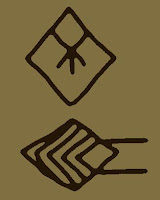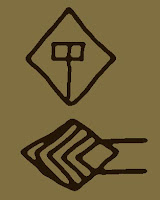 |
| Indus sign IX 16 (top) and closest analog, proto-cuneiform MUNSZUB, "hair, pelt." |
Sign IX 16 in my list derives from KP390 and W396, but it does not appear in my database of inscriptions. I call it VEE AND TRI-FORK IN DIAMOND, a descriptive phrase. It is a diamond with the usual “V” shape attached to the top, inside. But there is also an inverted “dubya” or the top of a trident, attached to the base of the “V.” Wells observes two, both from Harappa (or, relying on his later book, Epigraphic Approaches to Indus Writing, it occurs five times). All of the occurrences are on tablets, many of which I cannot discern as they do not photograph well.
This sign contains the same basic elements seen in the previous symbol, VEE IN DIAMOND WITH ATTACHED TRI-FORK (IX 15). But the “trident” portion appears on the outer surface of the diamond in IX 15, while it is inside the diamond and attached to the “V” in IX 16. Should these two be considered variants of a single sign? Since neither occurs even a dozen times, we cannot use statistics to answer the answer. The two do not seem to occur together, but this might be nothing more than coincidence given their sparsity in the record.
 |
| Indus sign IX 17 (top) and its closest analog, proto-cuneiform MUNSZUB, "hair, pelt." |
 |
| Detail from seal M-101 with inscription: CIRCLED VEE / BI-QUOTES // EARPHONES ON BI-FORK / POT // STRIPED TRIANGLE (6 stripes) / TRI-FORK. |
 |
| Proto-cuneiform striped triangle NI~a, "oil, cream, butter" (on left). |
 |
| Detail from block of Luwian text -- note striped triangle in top register near left side, URBS, "city," as well as three examples of doubled striped triangles, REGIO, "country." |
There are Indus triangles with two, three, four, five, six, and perhaps even seven internal stripes, as I count them:
- Triangle with 2 stripes: 1 occurrence (M-1307)
- Triangle with 3 stripes: 9 occurrences (?) (M-29, M-269, M-362, M-453?, M-523, , M-961, M-1363?; K-63; Ns-9?)
- Triangle with 4 stripes: 42 occurrences (M-30, M-245?, M-374, M-551 through M-565?, M-678, M-809, M-861?, M-937, M-1353, M-1503 through M-1513?; H-139, H-157, H-187, H-641, H-666, H-707 through 710)
- Triangle with 5 stripes: 6 occurrences ( M-174?, M-246?, M-408, M-516, M-517, M-1318)
- Triangle with 6 stripes: 10 occurrences (H-13; L-22; M-14, M-101, M-374, M-859, M-1095, M-1271; Ad-4?, Ad-8?)
- Triangle with 7 stripes: 2 occurrences (H-599; M-58, possibly M-551??)
Leaving aside such difficult decisions of how to group – or separate – striped triangles, we come to COMB BELTED ASTERISK (IX 19). It occurs elsewhere as KP249 and W435. In form, it is an “X” with two verticals or posts crossing it – the “asterisk” portion. In addition, there is a “comb” lying horizontally across the middle, with the “tines” pointing downward. This ligature – if that is what it is – occurs just once, at Mohenjo daro (M-391). I see nothing comparable in the scripts of other cultures.
 |
| Tablet H-952, sides A and B (reading right to left): FOOTED STOOL WITH HAIRY LEGS / POT (A side); FOUR POSTS / CUP (B side). |
Wells often distinguishes two signs when they mirror each other in this way. But he does not do so here. Perhaps that is because the Harappan occurrence appears on a tablet, while the Mohenjo daro examples are on seals. We expect reversal of sign order between these two types of object, since the seals were used for stamping while the tablets were “read” as is. It would make sense for the symbols themselves to reverse as well. But sometimes this does not happen (e.g., the HAIRY HUNCHBACK appears on multiple tablets with the “head” to the right as on H-934, as well as with the “head” on the left as on H-933). This kind of failure to reverse signs also occurs on cylinder seals from the Near East, though (Collon REF). It is possible that the appearance of both types on seals is a “scribal error” so to speak. But it is hard to see why the same error should occur on tablets too. Still, it does seem to happen that way. Note that the otherwise identical inscriptions on tablets H-945B and H-946B read from right to left CUP / FOUR POSTS and FOUR POSTS / CUP, respectively.
Then we have FOOTED STOOL WITH MID EARS (IX 21 A), also seen enumerated as KP232 and W459. Here, the “feet” of the “stool” are on the right (although, since M-628 is a seal, both Wells and the Koskenniemi and Parpola team reverse the sign in their lists). But another instance has the “feet” on the other side (M-1134). Wells enumerates this version independently, as W468. I think there may be two more examples of the first “variant” (M-715, partially abraded, and M-1186, partly missing on the top edge).
 |
| Inscription from bar seal M-1262: DOUBLE EF TOPPED EXITS / FOOTED STOOL WITH MID OVAL / POTTED THREE / SINGLE QUOTE // FOUR QUOTES / E TRI-FORK (such a long prefix!). |
I see that the large iconic animal on the seals varies, the head of the unicorn on M-628 placed on the left of the seal, the head of the rhino on M-1134 placed on the right side. This suggests the possibility that the position of the animal’s head indicates the beginning of the inscription. It is a handy hypothesis as long as we restrict our view to occurrences of this sign, IX21. But it collapses when we widen our view. For example, the unicorn on C-17 is unusually positioned with its head to the right. But the left-most sign is HORNED MAN (or WINGED MAN), followed by POT on the right (and MAN down beneath the unicorn’s head in place of the usual cult stand). Since POT is a terminal sign (as is MAN), we would not want to read it before HORNED/WINGED MAN.
 |
| Detail from seal M-17 with inscription: FOOTED STOOL WITH MID EARS (or oval?) / CIRCLED TRIPLE BRICK / BI-QUOTES // STACKED SIX / TRI-FORK. |


I like this information Thanks for sharing this. I would like to these articles and I have confusion but I read your news and I easy understood
ReplyDeleteBuyback your old diamond ring
I like this information Thanks for sharing this. I would like to these articles and I have confusion but I read your news and I easy understood
ReplyDeleteFloral solitaire earrings